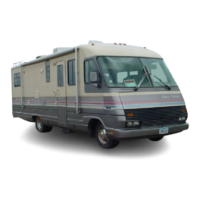52
Discovery, Discovery LXE, Pace Arrow, and Pace Arrow LXEt
mounting location is mandated for
CO detectors; only that they be
installed in accordance with their
listing. The installation of the CO
detector mounting bracket alone
will be considered acceptable as
long as the CO detector is provided.
A CO detector is required to
be installed in any RV that either
contains an internal combustion
engine or is designed to have
one installed. This would include
all motorized RV’s, regardless of
whether the fuel source is gasoline,
diesel, propane, or other alternate
fuel. This would also include an
RV equipped with a generator
or designed to accommodate
future installation of a generator
(commonly called “generator prep”
setups). This would not include
RV’s equipped to store or transport
internal combustion engine vehicles.
Also, all truck campers must
have a CO detector installed, since
an internal combustion engine is
ultimately present once the truck
camper is mounted on a pickup
truck.”
INFORMATION:
Refer to the CO detector
OEM manual for
detailed information and
maintenance information.
The motorhome is equipped
with a Carbon Monoxide detector.
Everyone is susceptible to Carbon
Monoxide poisoning. Carbon
Monoxide (CO) is a colorless,
odorless and tasteless gas that binds
with hemoglobin reducing the
body’s ability to absorb and carry
oxygen to vital organs. Even low
levels of CO poisoning have been
known to cause brain and other vital
organ damage in unborn infants,
with no effect on the mother.
When removed from exposure,
the symptoms dissipate as Carbon
Monoxide is expelled through the
lungs. Level of contamination in the
body reduces at half-life increments
at approximately four-hour
intervals. Treatment with Oxygen
will quicken recovery time.
In cases of mild exposure, the
symptoms may include: a slight
headache, nausea, vomiting and
fatigue. Some consider this a
“Flu-like Symptom.” Symptoms
for medium exposure may include
a severe throbbing headache,
drowsiness, confusion and fast heart
rate. Extreme exposure can result
in unconsciousness, convulsions,
cardiorespiratory failure and death.
Young children and household
pets may be the rst affected. Other
highly sensitive people include the
elderly and those with lung or heart
disease or anemia. The CO detector
is designed to detect the toxic CO
gas resulting from incomplete
combustion of any fuel. This can
be gasoline, propane, natural gas,
oil, charcoal or wood. Anything
that burns fuel such as engines,
generators, furnaces, gas stoves
or water heaters produce CO Gas.
Consequently, it is uncommon for
household smoke from cigarettes or
normal cooking to cause the alarm
to sound.
CAUTION:
Activation of this device
indicates the presence of
Carbon Monoxide (CO),
which can be fatal. A
concentration of above 100
PPM will cause a warning
condition. Individuals with
medical problems may
consider using detection
devices with lower Carbon
Monoxide alarming
capabilities. Prolonged
exposure to the alarm in
close proximity may be
harmful to hearing.
WARNING:
Constant beeping and a
flashing red light means
CO gas has been detected.
Shut off all sources of CO
such as propane appliances,
the engine, generator etc.
Open vents and windows to
ventilate the motorhome.
Evacuate the motorhome
until conditions are safe
to re-enter. Determine the
source of the alarm and
have the problems corrected
before resuming operation.
The CO detector is wired to the
house batteries. This allows reliable
protection by alerting to the build
up of potentially dangerous levels of
Carbon Monoxide. Once powered,
the detector will perform a brief
warm-up and self-check prior to
monitoring for CO gas.
Operation
The detector is equipped with
a self-cleaning CO sensor and
requires a ten minute initial warm-
up period to clean the sensor
element and achieve stabilization.
During the warm-up period, the
green power light will ash On and
Off. The green power light should
be lit when the power is on. If the
light is not lit, turn off the power
and check all wire connections. If
the power is on and the connections
are correct, but the indicator still
does not illuminate, the detector
should be returned for service. Do
not attempt to x the detector. The
indicator light displays a specic
color to monitor along with a
matching sound pattern.
Indicator Lights and Sound
Patterns:
Normal operation is
indicated by a green light
and no alarm. The CO
detector has power and is
sensing for the presence of
CO gas.
Flashing red indicates
a low CO gas presence
accompanied by four beeps
then off for ve seconds.

